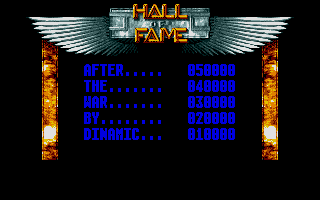Retro Replay Review
Gameplay
After the War delivers fast-paced side-scrolling action that keeps you on your toes from the very first level. You control Jonathan “Jungle” Rogers as he blasts through hordes of hostile scavengers and feral thieves roaming the irradiated streets of Manhattan. The core shooting mechanics are tight and responsive, offering a steady ramp-up in difficulty that feels fair yet challenging.
(HEY YOU!! We hope you enjoy! We try not to run ads. So basically, this is a very expensive hobby running this site. Please consider joining us for updates, forums, and more. Network w/ us to make some cash or friends while retro gaming, and you can win some free retro games for posting. Okay, carry on 👍)
Throughout your journey, you unlock a handful of special moves—dodge rolls, charged shots, and a short-range melee strike—that add a satisfying layer of strategy to each encounter. Timing your dodge to slip past a charging brute or unleashing a fully charged blast to clear a cramped corridor turns every firefight into a small puzzle. Resource management also comes into play, since ammunition and health pickups are scarce in later stages.
The level design mixes standard street environments with industrial complexes and makeshift refugee camps, each filled with diversions like destructible cover, environmental hazards, and hidden ammo caches. Boss fights, most notably the showdown against the manic Professor McJerin’s biomechanical guardians, introduce unique attack patterns that force you to learn and adapt rather than simply spray and pray. This variety keeps the gameplay loop fresh across its moderate length.
Graphics
Visually, After the War embraces a stylized, gritty pixel-art aesthetic that evokes classic 16-bit era shooters while enhancing them with modern lighting and particle effects. Explosions scatter glowing debris, muzzle flashes carve through the gloom, and dynamic weather systems—acid rain, radioactive fog—add atmosphere to the ruined cityscape.
The character sprites are well-animated, conveying weight and impact in every jump, dodge, and gunshot. Enemy designs range from shambling mutants with makeshift armor to towering mechanical sentries, each with vibrant details that make combat encounters memorable. Background layers scroll at different speeds, creating a convincing sense of depth as you traverse block after block of decaying infrastructure.
While the overall palette leans heavily into muted browns and sickly greens to communicate the post-nuclear setting, occasional bright neon signs and flickering holograms remind you that Manhattan’s soul still fights to shine through. Cutscenes use a slightly higher resolution to emphasize dramatic plot points, ensuring story beats feel just as polished as the gameplay moments.
Story
Set in the aftermath of a devastating 2019 nuclear exchange, After the War drops you into a deserted Manhattan that’s been renamed the “asphalt jungle.” Jonathan Rogers, known in underground circles as “Jungle Rogers,” is your everyman hero—tough yet relatable, haunted by the collapse of civilization but driven by hope. His mission: reach the airdrop platform XV-238 and escape to the outer colonies.
The narrative unfolds through brief in-game text and occasional comic-style panels, capturing the urgency of Rogers’ trek and the madness of Professor McJerin, a schizophrenic assassin turned warped scientist. McJerin’s dialogue is delivered via scrambled radio transmissions that echo through empty subway tunnels, heightening a sense of isolation and looming danger. These story snippets provide motivation without bogging down the action with lengthy cutscenes.
Secondary characters—like a former cop turned scavenger informant or the survivors trapped in makeshift barricades—add emotional weight. Their side quests and optional rescues offer insights into the broken world and reward you with extra supplies. By the time you confront McJerin himself, you’ve witnessed the full spectrum of human desperation and resilience in a world gone mad.
Overall Experience
After the War strikes a satisfying balance between classic run-and-gun sensibilities and modern design flourishes. The game’s length, around six to eight hours for a first playthrough, is just right for maintaining intensity without overstaying its welcome. Replayability comes from hidden challenge rooms and a time-attack mode that pushes you to refine your skills.
The audio design amplifies the tense atmosphere: a brooding synth soundtrack underscores each level, while layered sound effects—from distant nuclear blasts to the rattle of gunfire—immerse you in ruined Manhattan. Occasional audio logs hint at the greater scope of the apocalypse, painting a broader picture of a world on the brink.
For fans of side-scrolling shooters and post-apocalyptic tales, After the War delivers a robust package. Its crisp controls, stylish graphics, and compelling narrative work in harmony to create an experience that feels both familiar and fresh. Whether you’re blasting through street gangs or facing off against McJerin’s monstrous creations, you’ll find plenty of thrills in this journey to airdrop platform XV-238.
 Retro Replay Retro Replay gaming reviews, news, emulation, geek stuff and more!
Retro Replay Retro Replay gaming reviews, news, emulation, geek stuff and more!









Reviews
There are no reviews yet.